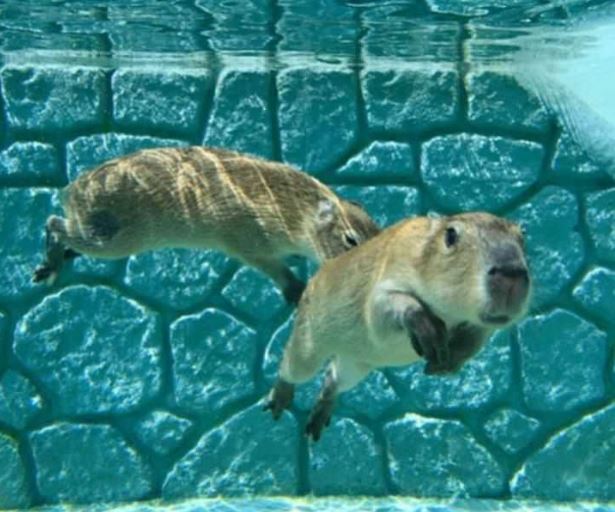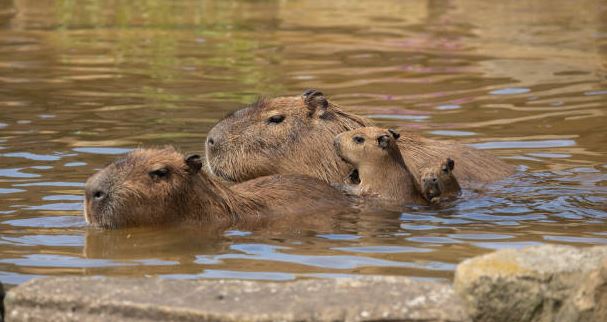Ever seen a capybara in water? I am sure you have seen the capybara enjoying hot baths. The capybara is a semi-aquatic animal, they seem to enjoy a great time in the water.
Right from the wild, this giant rodent has been found to enjoy staying around water bodies. The capybara is native to South America and it thrives in areas such as swamps, marshes, streams, lakes, rivers, ponds, etc.
Many are inquisitive to know the swimming ability of the capybara. The capybara has no set but has a set of webbed feet that help it swim. It can use its hands and feet to stroke downward, upward, right, and left sides. The hands and feet of this rodent help it paddle itself in the water and swim away from threats and potential predators.
Despite being the largest rodent in the world, the capybara has an impressive swimming speed. They can swim as fast as 10 kilometers per hour.
Capybaras have a special attraction for water. Apart from being great swimmers, they appear to spend more time in water than usual. They can stay underwater for up to five minutes and even take naps while floating on the water surface.
The capybara has a layer of protective fat beneath their skin that keeps it warm especially during cold periods, helping it survive the harsh cold season.

Moreover, this large-sized rodent enjoys bathing with fruits. Research has been done to know that capybara enjoy taking hot baths with lemons, yuzu, oranges, and other fruits. The study showed that bathing with fruits improved the skin condition of the capybaras.
In this article, you will learn how well the capybara can swim and what makes them skillful swimmers.
Can The Capybara Swim?
Capybaras are semi-aquatic, hinting at their ability to stay in water for some amount of time. This rodent can stay in the water alone or in the company of other capybaras.
Capybaras enjoy swimming or bathing in a pool of water with themselves. This allows them to interact and socialize with each other.
The capybara uses its hands to turn in any direction of its choice. Their hands help them adopt any swimming style of their choice, including upstroke and downstroke.
Moreover, their legs aid their motion in water. The capybara has webbed feet and a flattened tail, which improves their swimming ability. On average, the capybaras can swim as fast as 10kph.

While in water, this rodent lifts its head over the water while the rest of the body stays submerged underwater. This way, it keeps its face, ears, nose, and eyes to see what’s going on above the water’s surface.
When the capybara feels threatened by a predator close by, it dips itself in water and stays submerged until the threat is gone. They can keep their entire body submerged for over five minutes.
The capybara have a unique respiratory system that conserves air and helps them take quick breaths while underwater.
How Long Can The Capybara Swim?
The capybara, also known as water hog, can stay in water for as long as it wants. These rodents typically immerse themselves in water for 30 minutes or up to an hour to relax and cool their body temperature.
The capybara tends to enjoy its time in water during the hot season. Swimming and bathing in water will help release some body heat.
Like many animals, the capybara’s fur may have a lot of fleas, ticks, and mites, which bite and consume their blood. One of the measures the capybaras take to get rid of these insects on their fur is to stay underwater for a while.
Other creatures such as birds stay on the capybara’s back and scrabble for insects to feed.
How Fast Can The Capybara Swim?
The capybara’s legs are fast on land and in water. While on land, this giant rodent can run as fast as 35 mph (about 22 miles per hour) on land, and in water, it swims around 10 kilometers per hour (about 6 miles per hour).
Their webbed feet and hands boost their speed in water. Remarkably, the capybara can be as fast as penguins and alligators while in the water.
How Well Can The Capybara Dive?

Capybaras are incredible swimmers. They can dive and submerge themselves in the water for as long as they want. These rodents typically spend time in water bathing, playing, socializing, hiding from predators, or searching for food such as water plants.
The capybara can dive as deep as four feet. They stay on the top of the water or on the river bank before taking a dive. The impulse to dive comes mostly when they sight-threatening predators like anacondas and jaguars.
The capybara has sharp sensory organs that help them detect predators from afar. Their ears can detect the activity of lurking predators in the wild. When threatened, these rodents use their webbed feet to swim away from the danger area.
Can Capybara Hold Their Breath Underwater?
Apart from their impressive swimming ability, Capybaras can hold their breath underwater. Interestingly, they can stay underwater for over five minutes. However, they tend to spend less time underwater when tired, sick, or weak.

The rodent takes a quick inhale before going underwater. The capybara can go underwater in search of aquatic plants or to hide from predators. Some capybaras have held their breath underwater for more than five minutes due to threats.
Staying underwater is one of the surest ways for the capybara to evade dangerous predators.
Hot or Cold: What Kind of Water Do Capybaras Enjoy Swimming In?
Capybara enjoys swimming from their natural habitat in the wild. When it comes to choosing between hot and cold water, the capybara prefers taking hot baths.
These large rodents enjoy swimming in hot temperatures. We can’t forget that capybara is native to South American forests known for its hot, tropical climates. The capybara tend to relax in warm water.

However, they can still take a bath in cold water. Also, they prefer slow-moving waters such as ponds and shallow lakes rather than fast-flowing streams and rivers.
Now that you are equipped with this information, you can give your capybara a special treat by bathing it in a pool of warm water. Another good idea you can do is to fill the pool with citrus fruits such as oranges and lemons.
Can Capybaras Swim In a Chlorinated Water?
If you are constructing a pool for your pet capybara, make sure the water is as natural as possible. Don’t allow your capybara to swim in water filled with chemicals or in a chlorinated pool as such water contains chlorine dioxide, which can be harmful to the animal.
While the capybara will relish the chance of getting into any pool of water it finds, the water hog may not be smart enough to know if such water contains harmful chemicals.
Below are some reasons why you shouldn’t let your pet capybara swim in chlorinated pools:
- A high level of chlorine in the pool can kill the good bacteria and other micro-organisms in the capybara’s body. Not all bacteria are harmful to the body. Actually, the good bacteria in the body help it to digest food with ease.
- The capybara’s ears, eyes, and nose, can get irritated if it enters a chlorinated pool.
- Swimming in a chlorinated water pool will weaken the capybara’s body system and cause minor GI irritation.
- As you know, the capybara spends a lot of time in water and may occasionally drink some water while bathing. Any capybara that drinks water containing chlorine will become weak and feel restless. Also, the water hog will suffer from loss of appetite and some amounts of blood will flow from its nose.
- The biggest effect of letting your capybara swim in a capybara pool is that it can die if the level of chlorine in the water is above 0.5 gm/L.
Frequently Asked Questions
Is the capybara water-resistant?
The capybara is an amphibious animal, meaning it can stay in both water and land. This large rodent has a waterproof skin that has no high water retention. The capybara spends a lot of time in water to stay hydrated due to its dry skin.
They also have oily skins, which shield them from the effects of the sun and other parasites.
How deep can the capybara dive?
The capybaras are not only strong swimmers but also great divers. They can dive as deep as 4 feet below the water surface to find food, mostly aquatic plants, or hide from the sight of predators.
How long can capybaras hold their breath?
These rodents can stay underwater and hold their breath for as long as five minutes before coming up to inhale fresh air.
Where can I find capybaras?
The capybara lives around grasslands and forests near water sources such as swamps, marshes, rivers, lakes, streams, and ponds. They are great swimmers and enjoy spending time in the water playing, finding food, relaxing, evading predators, or interacting with themselves.
The capybara enjoys eating fresh vegetation. They are diurnal animals, meaning they are most active during the daytime. At night, these rodents find a cool shelter to rest.
Conclusion
The capybara thrives on land and in water. This giant rodent has webbed feet that help it move quickly on land and swim fast in water.
Swimming at the rate of 10km/hour shows that the capybara’s swimming speed is impressive, despite its tiny hands and feet. Moreover, the capybara has an incredible breath-retention ability, which allows it to stay submerged for up to 5 minutes.
If you have a pet capybara, ensure to provide it with a pool to serve as its swimming or bathing zone. However, be careful not to put your pet capybara in a chlorinated pool, which can be detrimental to its health.


![Capybara Meat And Its Culinary Uses - [Every You Should Know] Capybara Meat & Culinary Uses](https://capybaratips.com/wp-content/uploads/2023/03/Capybara-meat-250x200.webp)






